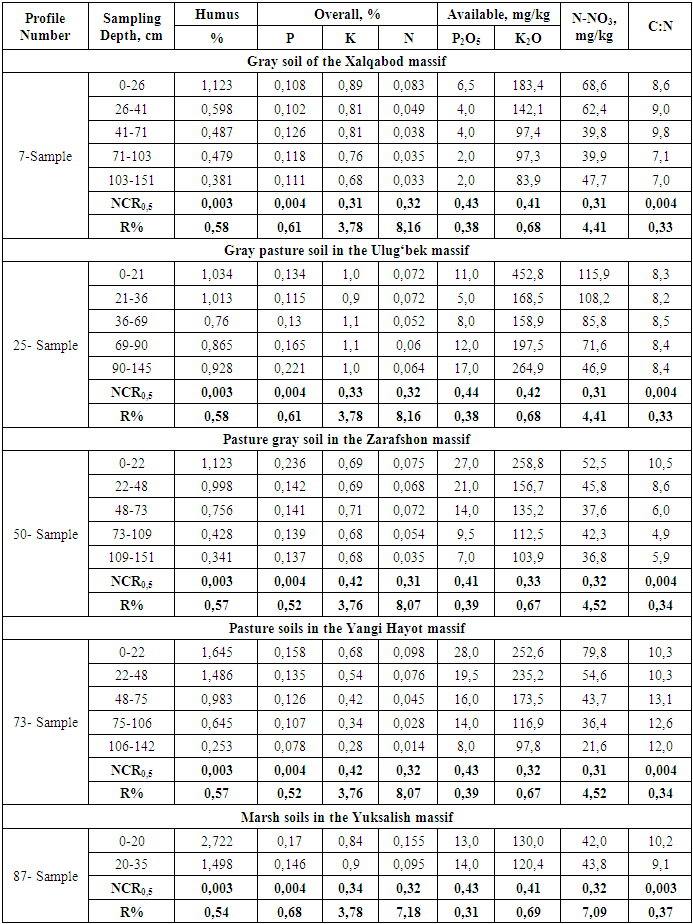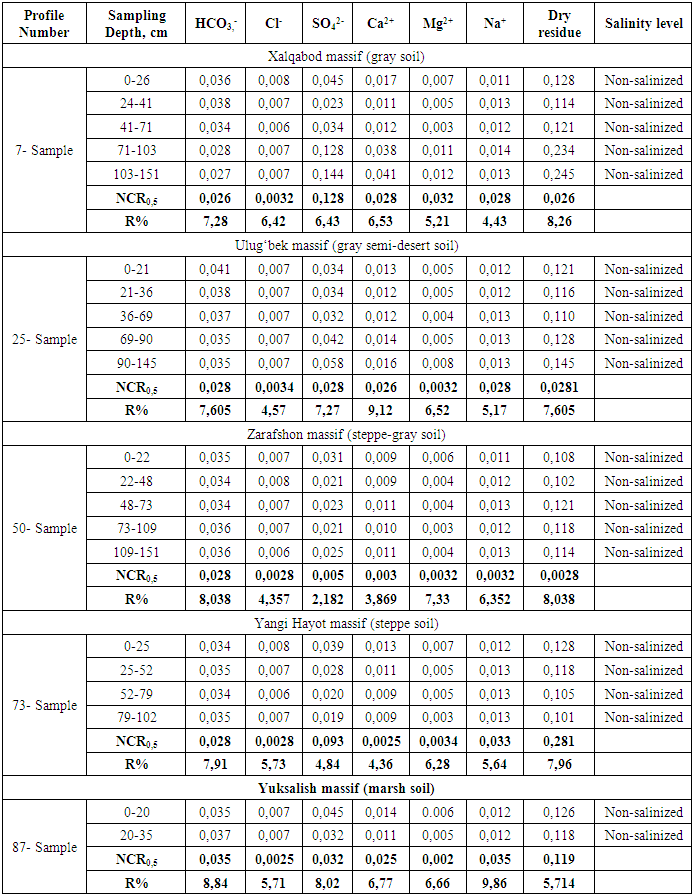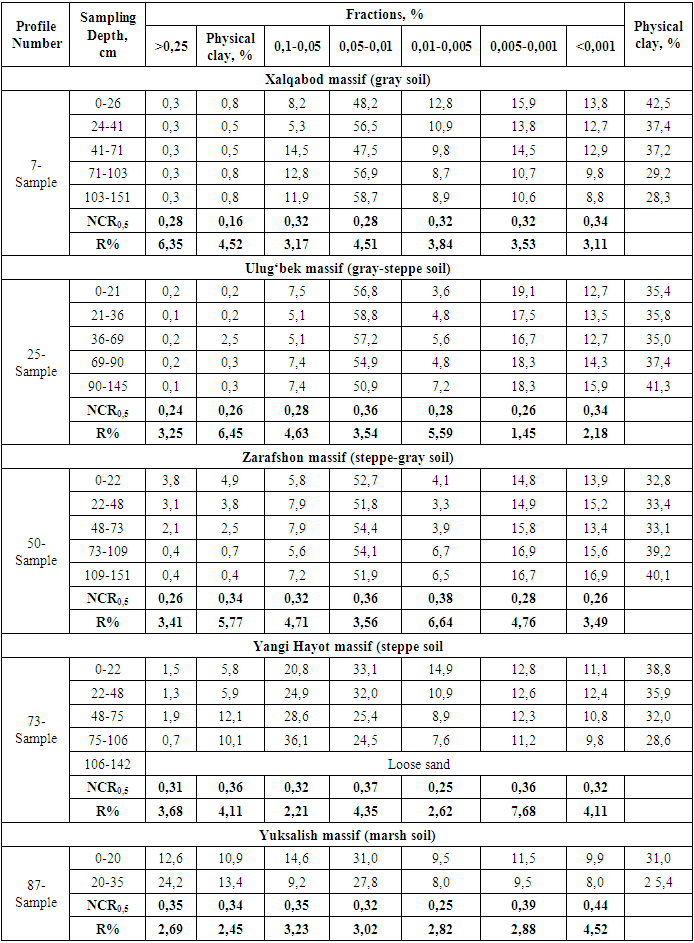-
Paper Information
- Paper Submission
-
Journal Information
- About This Journal
- Editorial Board
- Current Issue
- Archive
- Author Guidelines
- Contact Us
International Journal of Genetic Engineering
p-ISSN: 2167-7239 e-ISSN: 2167-7220
2025; 13(6): 119-123
doi:10.5923/j.ijge.20251306.07
Received: May 12, 2025; Accepted: Jun. 6, 2025; Published: Jun. 25, 2025

General Characteristics of Irrigated Grey Soils (Case Study: Yangiyo'l District, Tashkent Region)
Nazarova Yorqinoy Nurmakhmatovna1, Nabieva Gulchekhra Mirergashevna2
1Researcher, Department of Soil Science, National University of Uzbekistan named after Mirzo Ulugbek, Tashkent, Uzbekistan
2DSc., Associate Professor, Department of Soil Science, National University of Uzbekistan named after Mirzo Ulugbek, Tashkent, Uzbekistan
Copyright © 2025 The Author(s). Published by Scientific & Academic Publishing.
This work is licensed under the Creative Commons Attribution International License (CC BY).
http://creativecommons.org/licenses/by/4.0/

This study investigates the agrochemical properties, content of water-soluble salts, and mechanical composition of irrigated grey, meadow-grey, meadow-grey, meadow, and marshy soils in the Yangiyo'l district of the Tashkent region. The findings highlight the evolutionary development stages of these soils and provide insights into the changing properties of soils under irrigation.
Keywords: Irrigated grey, Meadow-grey, Meadow, and marshy soils, Fertility, Mechanical composition, Salinization
Cite this paper: Nazarova Yorqinoy Nurmakhmatovna, Nabieva Gulchekhra Mirergashevna, General Characteristics of Irrigated Grey Soils (Case Study: Yangiyo'l District, Tashkent Region), International Journal of Genetic Engineering, Vol. 13 No. 6, 2025, pp. 119-123. doi: 10.5923/j.ijge.20251306.07.
1. Introduction
- Currently, the intensive development of agriculture has led to increased land degradation, primarily due to soil erosion, depletion of nutrient reserves, increased salinity, and drought, all contributing to land deterioration. Notably, anthropogenic factors have led to the degradation of 34% (1,660 million ha) of agricultural lands [1].In Uzbekistan, soils are formed within vertical and horizontal zones, with grey soils developing predominantly in the central regions. These soils possess unique characteristics due to their soil-climatic and regional conditions. Grey soils are found in all regions except Karakalpakstan, Bukhara, Syrdarya, and Khorezm. In Tashkent region, they account for 12.6% of the country’s typical grey soils [2].Groundwater plays a key role in soil formation, leading to distinct soil types. M eadow soils form at depths of 1.0–2.0 m, while meadow-grey soils form at depths of 2.0–3.0 m. During the growing season, irrigation raises groundwater levels, fluctuating 1.0–1.5 m depending on the terrain. The genetic soil types in Yangiyo‘l district include irrigated typical grey, meadow-grey, meadow, and marshy-meadow soils. These soils vary in erosion, salinity, nutrient content, and mechanical composition due to topographic diversity.Therefore, it is essential to study the organic matter, chemical, and physicochemical properties of hydromorphic soils to scientifically maintain and improve fertility. This includes identifying the content of organic matter, physical-chemical properties, humus levels, and predicting evolutionary changes [3].Grey soil types within irrigated classifications include dark grey, typical grey, light grey, meadow-grey, and oasis variants [4].The cation exchange capacity in typical grey soils ranges from 9–11 meq/100 g in Zangiota and 9–14 meq/100 g in Yangiyo‘l. The exchange complex is saturated with alkaline earth metals, with calcium and magnesium making up 90–94%, and potassium and sodium comprising 6–10%. The total area of the studied land is 35,972 ha, of which 22,831.6 ha are irrigated agricultural lands [5].These lands are irrigated primarily through the Jon and Bo‘z water canals branching from the Chirchiq River. In upland areas, irrigation is supported by pumps. Collector-drainage systems maintain groundwater levels below critical thresholds [6].
2. Research Methods
- Field studies were conducted in the irrigated soils of Yangiyo‘l district, Tashkent region. Soil profiles and sampling were performed according to Dospekhov (1985) [7]. Chemical analysis followed guidelines from the 1977 “Methods of Agrochemical Analysis of Soils and Plants of Central Asia” and Arinushkina's manual. Analytical techniques included genetic-geographical, profile-geochemical, and chemical-analytical methods [8,9]. Humus distribution was studied per Toshqo‘ziev’s guidelines [10]. The research adhered to national soil survey protocols, with statistical analysis done in Microsoft Excel. Yangiyo‘l district, established on September 29, 1926, borders Kazakhstan (Turkistan region) and several Tashkent districts. Covering 0.42 thousand km², it is predominantly flat with some uplands. The district contains five terraces of the Chirchik River and is characterized by grey and meadow soils. Its continental climate supports vegetation such as reeds, wormwood, tamarisk, bindweed, couch grass, and others. Wildlife includes jackals, foxes, hares, badgers, and various birds [11].In the Xalqobod massif, soil profiles still exhibit residual signs of original grey coloration and weak carbonate accumulation. Nutrient levels (humus, total K, N, mobile P2O5, K2O, and N-NO3) are highest in the upper 0–41 cm layers. Total P, however, is higher in the deeper 103–151 cm layer. Similar trends were observed in Ulug‘bek, Zarafshon, Yangi Hayot, and Yuksalish massifs.
|
|
|
3. Conclusions
- Irrigation of gray soils formed on the Chirchik river terraces has led to gradual morphological and agrochemical changes that depend on the relief. The amounts of humus and nutrients increase towards semi-hydromorphic and hyd romorphic soils compared to automorphic soils (1.123–2.722%). Long-term irrigation has resulted in a gradual decrease in humus content in the lower soil layers of the studied soils. The soil types have shifted from pasture to marsh-pasture soils, reflecting changes in the water-air regime. Partial formation of agro-irrigation layers has been observed in some areas.The irrigated lands of the studied areas in Yangiyol district are non-saline and consist of various mechanical compositions. To maintain soil fertility and pr oductivity and increase crop yields continuously, comprehensive implementation of hydraulic, agrotechnical, and reclamation measures is required.To prevent groundwater rise and associated secondary salinization processes, it is crucial to regulate irrigation water use, technically re-equip and properly maintain irrigation canal and drainage systems, and to determine irrigation schedules, frequency, and norms accurately. This should consider soil and climatic conditions, crop types, growth periods, water requirements, groundwater depth, and other factors, ensuring strict adherence to irrigation regimes.
 Abstract
Abstract Reference
Reference Full-Text PDF
Full-Text PDF Full-text HTML
Full-text HTML

